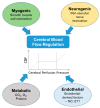Cerebral Blood Flow Regulation in Pregnancy, Hypertension, and Hypertensive Disorders of Pregnancy
- PMID: 31487961
- PMCID: PMC6769869
- DOI: 10.3390/brainsci9090224
Cerebral Blood Flow Regulation in Pregnancy, Hypertension, and Hypertensive Disorders of Pregnancy
Abstract
The regulation of cerebral blood flow (CBF) allows for the metabolic demands of the brain to be met and for normal brain function including cognition (learning and memory). Regulation of CBF ensures relatively constant blood flow to the brain despite changes in systemic blood pressure, protecting the fragile micro-vessels from damage. CBF regulation is altered in pregnancy and is further altered by hypertension and hypertensive disorders of pregnancy including preeclampsia. The mechanisms contributing to changes in CBF in normal pregnancy, hypertension, and preeclampsia have not been fully elucidated. This review summarizes what is known about changes in CBF regulation during pregnancy, hypertension, and preeclampsia.
Keywords: autoregulation; blood-brain barrier; cerebral blood flow; chronic hypertension; eclampsia; preeclampsia; pregnancy; superimposed preeclampsia.
Conflict of interest statement
The authors declare no conflict of interest. The funders had no role in the design of the study; in the collection, analyses, or interpretation of data; in the writing of the manuscript, or in the decision to publish the results.
Figures




Similar articles
-
Cerebral autoregulation in different hypertensive disorders of pregnancy.Am J Obstet Gynecol. 2015 Apr;212(4):513.e1-7. doi: 10.1016/j.ajog.2014.11.003. Epub 2014 Nov 7. Am J Obstet Gynecol. 2015. PMID: 25446701
-
Blood-Brain Barrier Dysfunction in Hypertensive Disorders of Pregnancy.Curr Hypertens Rep. 2023 Dec;25(12):463-470. doi: 10.1007/s11906-023-01288-8. Epub 2023 Nov 24. Curr Hypertens Rep. 2023. PMID: 37996623 Review.
-
Investigating Maternal Brain Alterations in Preeclampsia: the Need for a Multidisciplinary Effort.Curr Hypertens Rep. 2019 Aug 2;21(9):72. doi: 10.1007/s11906-019-0977-0. Curr Hypertens Rep. 2019. PMID: 31375930 Review.
-
Cerebral blood flow in hypertension.J Cardiovasc Pharmacol. 1985;7 Suppl 2:S94-8. doi: 10.1097/00005344-198507002-00018. J Cardiovasc Pharmacol. 1985. PMID: 2409378 Review.
-
Cerebral blood flow in rats with renal and spontaneous hypertension: resetting of the lower limit of autoregulation.J Cereb Blood Flow Metab. 1982 Sep;2(3):347-53. doi: 10.1038/jcbfm.1982.35. J Cereb Blood Flow Metab. 1982. PMID: 7096459
Cited by
-
Investigation Regarding Early Cognitive Function of Women in the Postpartum Period and the Analysis of Influencing Factors.Risk Manag Healthc Policy. 2021 Sep 10;14:3747-3754. doi: 10.2147/RMHP.S309553. eCollection 2021. Risk Manag Healthc Policy. 2021. PMID: 34531692 Free PMC article.
-
Preeclampsia history and postpartum risk of cerebrovascular disease and cognitive impairment: Potential mechanisms.Front Physiol. 2023 Mar 31;14:1141002. doi: 10.3389/fphys.2023.1141002. eCollection 2023. Front Physiol. 2023. PMID: 37064920 Free PMC article. Review.
-
Maternal Optical Coherence Tomography Angiography Changes Related to Small for Gestational Age Pregnancies.Transl Vis Sci Technol. 2020 Dec 3;9(13):4. doi: 10.1167/tvst.9.13.4. eCollection 2020 Dec. Transl Vis Sci Technol. 2020. PMID: 33344048 Free PMC article.
-
Advanced Maternal Age Impairs Uterine Artery Adaptations to Pregnancy in Rats.Int J Mol Sci. 2022 Aug 16;23(16):9191. doi: 10.3390/ijms23169191. Int J Mol Sci. 2022. PMID: 36012456 Free PMC article.
-
Cerebral Blood Flow Autoregulation in Offspring From Experimentally Preeclamptic Rats and the Effect of Age.Front Physiol. 2022 Jun 6;13:924908. doi: 10.3389/fphys.2022.924908. eCollection 2022. Front Physiol. 2022. PMID: 35733984 Free PMC article.
References
-
- Cipolla M.J. Integrated Systems Physiology: From Molecule to Function. Morgan & Claypool Life Sciences; San Rafael, CA, USA: 2009. The Cerebral Circulation. - PubMed
Publication types
Grants and funding
LinkOut - more resources
Full Text Sources
Miscellaneous

